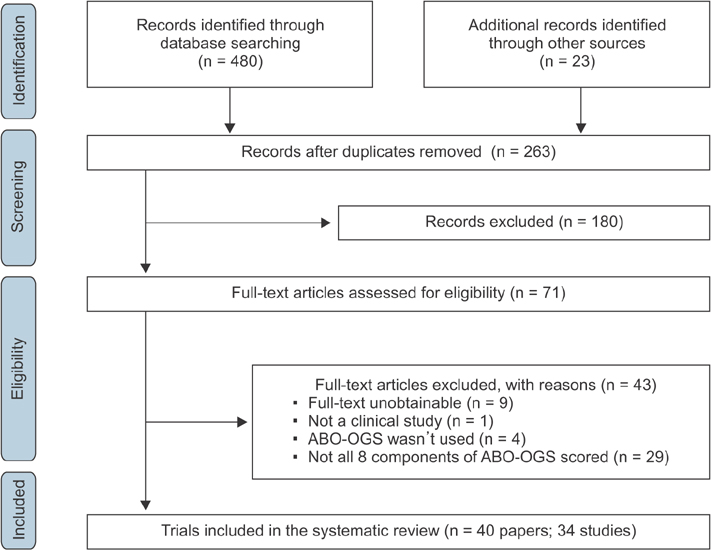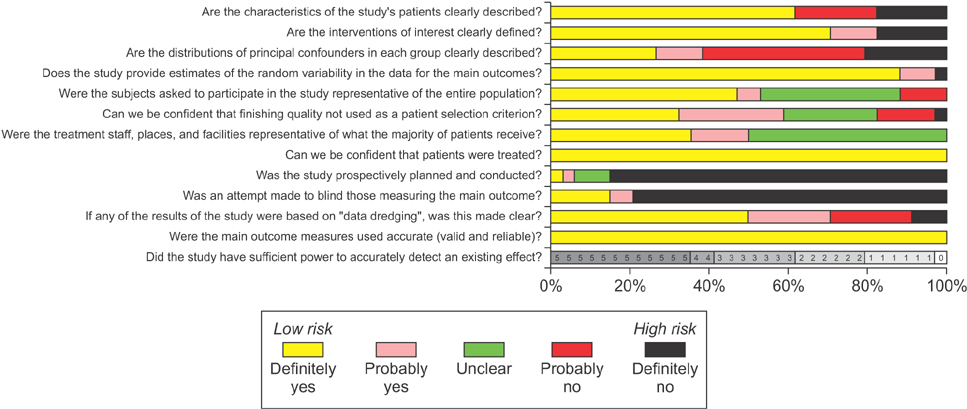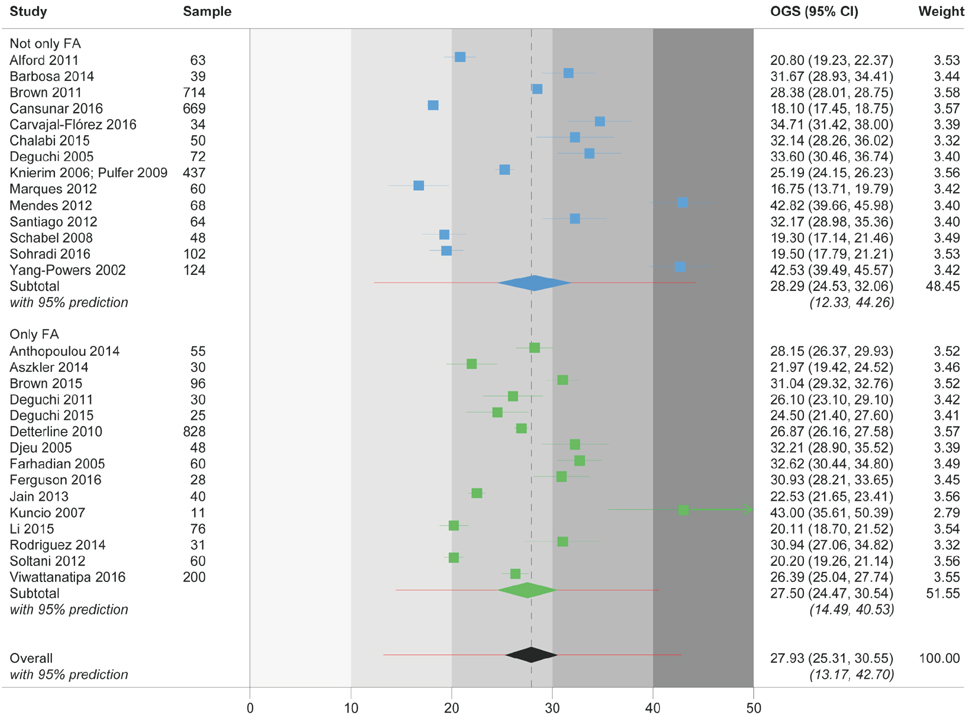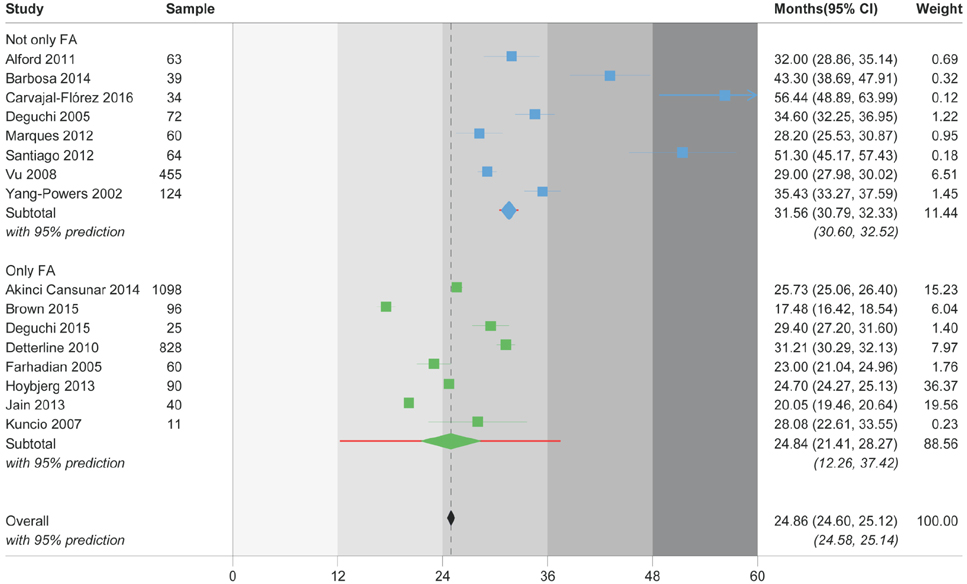Korean J Orthod.
2017 Nov;47(6):401-413. 10.4041/kjod.2017.47.6.401.
Outcomes of comprehensive fixed appliance orthodontic treatment: A systematic review with meta-analysis and methodological overview
- Affiliations
-
- 1Clinic of Orthodontics and Pediatric Dentistry, Center of Dental Medicine, University of Zurich, Zurich, Switzerland. snpapage@gmail.com
- KMID: 2392187
- DOI: http://doi.org/10.4041/kjod.2017.47.6.401
Abstract
OBJECTIVE
The aim of this systematic review was to assess the occlusal outcome and duration of fixed orthodontic therapy from clinical trials in humans with the Objective Grading System (OGS) proposed by the American Board of Orthodontics.
METHODS
Nine databases were searched up to October 2016 for prospective/retrospective clinical trials assessing the outcomes of orthodontic therapy with fixed appliances. After duplicate study selection, data extraction, and risk of bias assessment according to the Cochrane guidelines, random-effects meta-analyses of the mean OGS score and treatment duration were performed and 95% confidence intervals (CIs) were calculated.
RESULTS
A total of 34 relevant clinical trials including 6,207 patients (40% male, 60% female; average age, 18.4 years) were identified. The average OGS score after treatment was 27.9 points (95% CI, 25.3-30.6 points), while the average treatment duration was 24.9 months (95% CI, 24.6-25.1 months). There was no significant association between occlusal outcome and treatment duration, while considerable heterogeneity was identified. In addition, orthodontic treatment involving extraction of four premolars appeared to have an important effect on both outcomes and duration of treatment. Finally, only 10 (39%) of the identified studies matched compared groups by initial malocclusion severity, although meta-epidemiological evidence suggested that matching may have significantly influenced their results.
CONCLUSIONS
The findings from this systematic review suggest that the occlusal outcomes of fixed appliance treatment vary considerably, with no significant association between treatment outcomes and duration. Prospective matched clinical studies that use the OGS tool are needed to compare the effectiveness of orthodontic appliances.
MeSH Terms
Figure
Cited by 1 articles
-
Effects of self-ligating brackets and other factors influencing orthodontic treatment outcomes: A prospective cohort study
Min-Ho Jung
Korean J Orthod. 2021;51(6):397-406. doi: 10.4041/kjod.2021.51.6.397.
Reference
-
1. Pandis N, Polychronopoulou A, Eliades T. Active or passive self-ligating brackets? A randomized controlled trial of comparative efficiency in resolving maxillary anterior crowding in adolescents. Am J Orthod Dentofacial Orthop. 2010; 137:12.e1–12.e6. discussion 12-3.
Article2. Pandis N, Polychronopoulou A, Katsaros C, Eliades T. Comparative assessment of conventional and self-ligating appliances on the effect of mandibular intermolar distance in adolescent nonextraction patients: a single-center randomized controlled trial. Am J Orthod Dentofacial Orthop. 2011; 140:e99–e105.
Article3. Papageorgiou SN, Konstantinidis I, Papadopoulou K, Jäger A, Bourauel C. A systematic review and metaanalysis of experimental clinical evidence on initial aligning archwires and archwire sequences. Orthod Craniofac Res. 2014; 17:197–215.
Article4. Papageorgiou SN, Konstantinidis I, Papadopoulou K, Jäger A, Bourauel C. Clinical effects of pre-adjusted edgewise orthodontic brackets: a systematic review and meta-analysis. Eur J Orthod. 2014; 36:350–363.
Article5. Papageorgiou SN, Gölz L, Jäger A, Eliades T, Bourauel C. Lingual vs. labial fixed orthodontic appliances: systematic review and meta-analysis of treatment effects. Eur J Oral Sci. 2016; 124:105–118.
Article6. Casko JS, Vaden JL, Kokich VG, Damone J, James RD, Cangialosi TJ, et al. Objective grading system for dental casts and panoramic radiographs. American Board of Orthodontics. Am J Orthod Dentofacial Orthop. 1998; 114:589–599.7. Mislik B, Konstantonis D, Katsadouris A, Eliades T. University clinic and private practice treatment outcomes in Class I extraction and nonextraction patients: a comparative study with the American Board of Orthodontics Objective Grading System. Am J Orthod Dentofacial Orthop. 2016; 149:253–258.
Article8. Pinskaya YB, Hsieh TJ, Roberts WE, Hartsfield JK. Comprehensive clinical evaluation as an outcome assessment for a graduate orthodontics program. Am J Orthod Dentofacial Orthop. 2004; 126:533–543.
Article9. Cangialosi TJ, Riolo ML, Owens SE Jr, Dykhouse VJ, Moffitt AH, Grubb JE, et al. The ABO discrepancy index: a measure of case complexity. Am J Orthod Dentofacial Orthop. 2004; 125:270–278.
Article10. Dougherty HL. The orthodontic standard of care. Am J Orthod Dentofacial Orthop. 1991; 99:482–485.
Article11. Vig KWL, Firestone A, Wood W, Lenk M. Quality of orthodontic treatment. Semin Orthod. 2007; 13:81–87.
Article12. Mavreas D, Athanasiou AE. Factors affecting the duration of orthodontic treatment: a systematic review. Eur J Orthod. 2008; 30:386–395.
Article13. Tsichlaki A, Chin SY, Pandis N, Fleming PS. How long does treatment with fixed orthodontic appliances last? A systematic review. Am J Orthod Dentofacial Orthop. 2016; 149:308–318.
Article14. Higgins JPT, Green S. Cochrane Handbook for Systematic Reviews of Interventions. Version 5.1.0 [Internet]. The Cochrane Collaboration;2011. updated 2011 Mar. cited 2016 Dec 3. Available from: http://handbook.cochrane.org/.15. Liberati A, Altman DG, Tetzlaff J, Mulrow C, Gøtzsche PC, Ioannidis JP, et al. The PRISMA statement for reporting systematic reviews and meta-analyses of studies that evaluate health care interventions: explanation and elaboration. J Clin Epidemiol. 2009; 62:e1–e34.
Article16. Downs SH, Black N. The feasibility of creating a checklist for the assessment of the methodological quality both of randomised and non-randomised studies of health care interventions. J Epidemiol Community Health. 1998; 52:377–384.
Article17. Veroniki AA, Jackson D, Viechtbauer W, Bender R, Bowden J, Knapp G, et al. Methods to estimate the between-study variance and its uncertainty in metaanalysis. Res Synth Methods. 2016; 7:55–79.
Article18. Papageorgiou SN. Meta-analysis for orthodontists: Part I--How to choose effect measure and statistical model. J Orthod. 2014; 41:317–326.
Article19. Papageorgiou SN. Meta-analysis for orthodontists: Part II--Is all that glitters gold. J Orthod. 2014; 41:327–336.20. IntHout J, Ioannidis JP, Rovers MM, Goeman JJ. Plea for routinely presenting prediction intervals in meta-analysis. BMJ Open. 2016; 6:e010247.
Article21. Ioannidis JP. Interpretation of tests of heterogeneity and bias in meta-analysis. J Eval Clin Pract. 2008; 14:951–957.
Article22. Tsichlaki A, Chin SY, Pandis N, Fleming PS. How long does treatment with fixed orthodontic appliances last? A systematic review. Am J Orthod Dentofacial Orthop. 2016; 149:308–318.
Article23. Djeu G, Shelton C, Maganzini A. Outcome assessment of Invisalign and traditional orthodontic treatment compared with the American Board of Orthodontics objective grading system. Am J Orthod Dentofacial Orthop. 2005; 128:292–298. discussion 298.
Article24. Viwattanatipa N, Buapuean W, Komoltri C. Relationship between discrepancy index and the objective grading system in thai board of orthodontics patients. Orthod Waves. 2016; 75:54–63.
Article25. Papageorgiou SN, Xavier GM, Cobourne MT. Basic study design influences the results of orthodontic clinical investigations. J Clin Epidemiol. 2015; 68:1512–1522.
Article26. Papageorgiou SN, Koretsi V, Jäger A. Bias from historical control groups used in orthodontic research: a meta-epidemiological study. Eur J Orthod. 2017; 39:98–105.
Article27. Marques LS, Freitas ND Jr, Pereira LJ, Ramos-Jorge ML. Quality of orthodontic treatment performed by orthodontists and general dentists. Angle Orthod. 2012; 82:102–106.
Article28. CoHong M, Kook YA, Baek SH, Kim MK. Comparison of treatment outcome assessment for class I malocclusion patients: peer assessment rating versus American board of orthodontics-objective grading system. J Korean Dent Sci. 2014; 7:6–15.
Article29. Hong M, Kook YA, Kim MK, Lee JI, Kim HG, Baek SH. The Improvement and Completion of Outcome index: A new assessment system for quality of orthodontic treatment. Korean J Orthod. 2016; 46:199–211.
Article30. Pocock SJ, Assmann SE, Enos LE, Kasten LE. Subgroup analysis, covariate adjustment and baseline comparisons in clinical trial reporting: current practice and problems. Stat Med. 2002; 21:2917–2930.
Article31. Papageorgiou SN, Papadopoulos MA, Athanasiou AE. Reporting characteristics of meta-analyses in orthodontics: methodological assessment and statistical recommendations. Eur J Orthod. 2014; 36:74–85.
Article32. Hernández AV, Steyerberg EW, Habbema JD. Covariate adjustment in randomized controlled trials with dichotomous outcomes increases statistical power and reduces sample size requirements. J Clin Epidemiol. 2004; 57:454–460.
Article33. Papageorgiou SN, Kloukos D, Petridis H, Pandis N. Publication of statistically significant research findings in prosthodontics & implant dentistry in the context of other dental specialties. J Dent. 2015; 43:1195–1202.
Article





